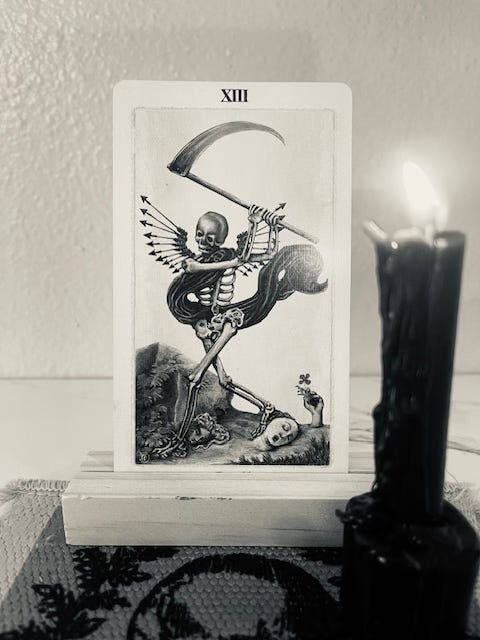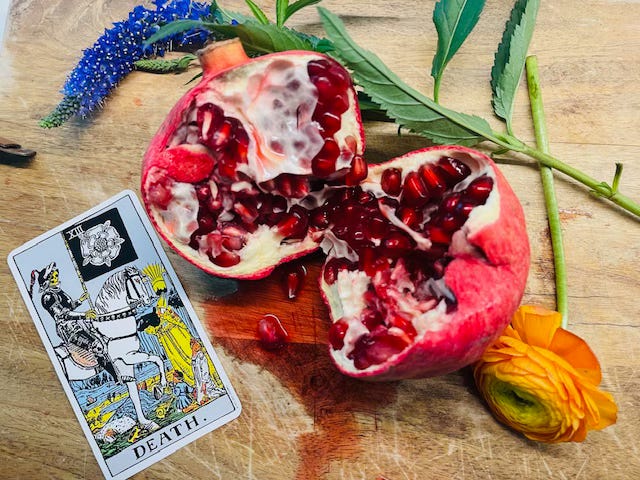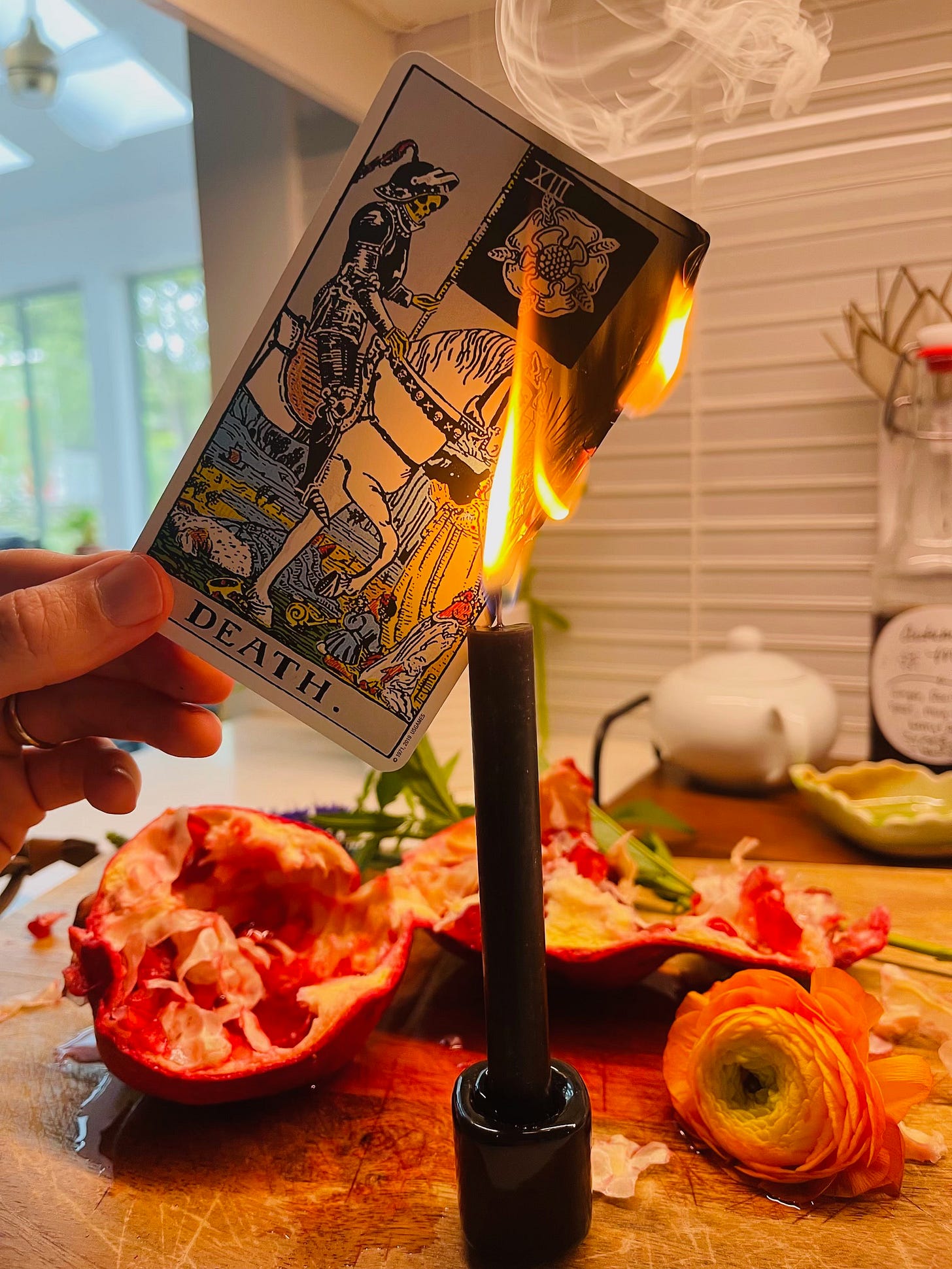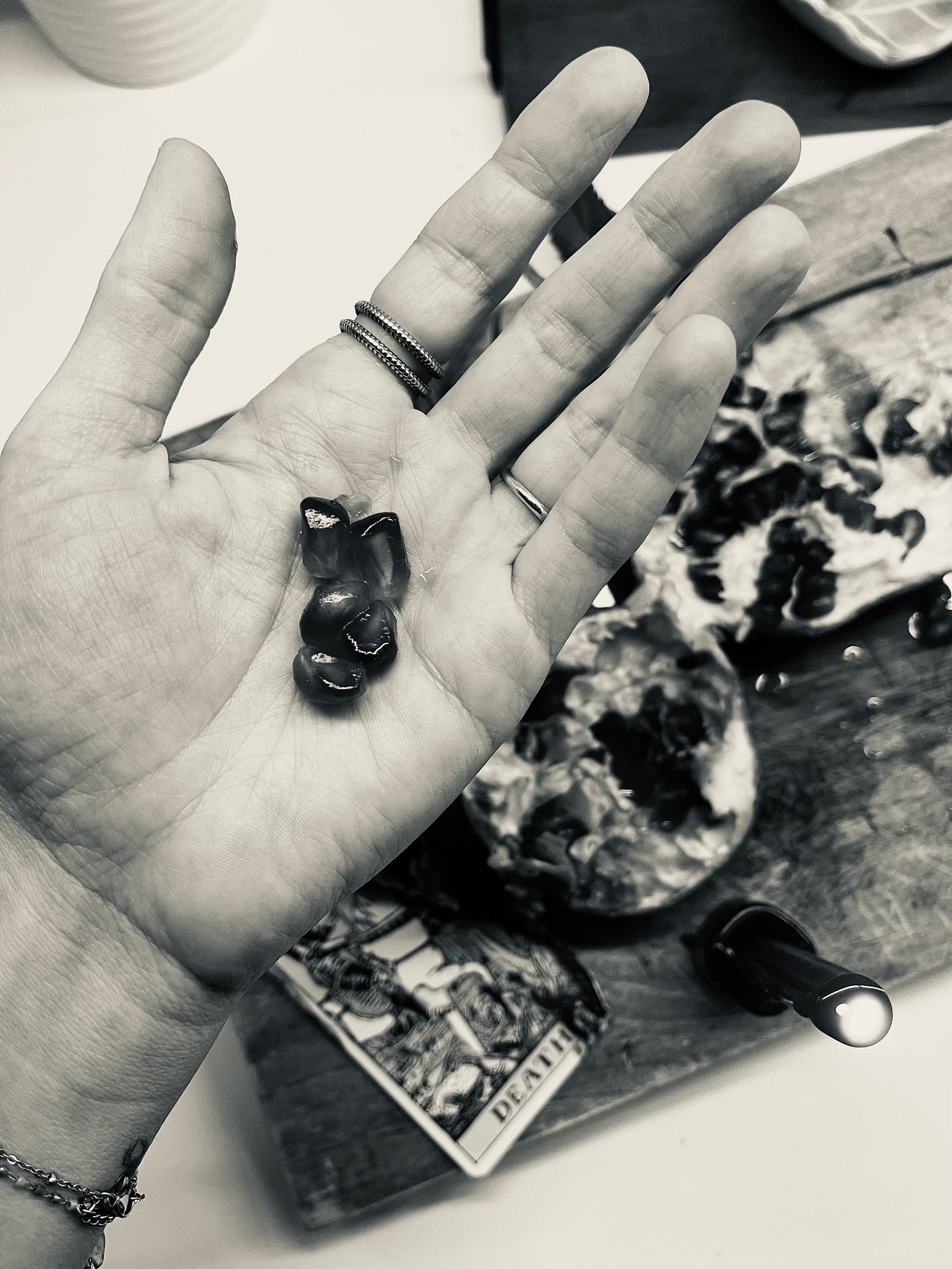He comes cloaked in his dark mantle, scythe swinging like the pendulum of a clock, gathering the grist of seasons passed. Some years his harvest feeds us, some years we feed his harvest, but Death is as inevitable as the change he portends. And Death is here for us.
In his wake: uncertainty, chaos, grief, but also possibility, creativity, and evolution.
If you are already up to your ears in processing the outcome of the recent U.S. election, I welcome you to skip passed these next few paragraphs. I feel it’s important to give ourselves respite from collective emoting around current events when needed. Yet, our creative and spiritual lives, (tarot practice specifically), can offer support during times of political upheaval. (I appreciated this poem and post on 5 of cups from the Tarot Professor). And I feel I would be remiss if I didn’t share how the Death archetype is helping me to cope. As always, take what resonates with you and leave the rest.
***If you want to skip ahead, I will shift into a less election-specific discussion of “Death as creative force” after the image of the pomegranate.***
No matter which candidate you supported, this election was always going to culminate in the death of one possible path forward and the birth of another. For my community, this is not the birth we would have hoped for. But I choose to hold space for anyone who cast their vote with the integrity of their own values and convictions, and I trust that they acted to the best of their ability, given their perspective and current knowledge—which are, like mine, fundamentally limited.
Some of us are looking at the path ahead with renewed hope, renewed energy. Others of us look ahead with dread. With despair. None of us has the full picture—because the outcome is still unfolding. And Death, the ultimate endpoint, cannot help but release us into infinite realms of possibility.
It might not feel that way. Not at all. We might feel pressed in on either side. Squeezed to near suffocation. And it’s impossible not to look around the darkened landscape and wish that things had moved in a different direction; just as it’s impossible not to sit at a loved one’s gravesite and wish they were still alive. This is Death.
When Death comes around, about the only comfort we can give ourselves is the knowledge that the vibrancy, the energy, the life of the person, or idea, or project, or candidacy that we are mourning was not wasted. The love that they shared, the hope, the connection lives on.
In October I attended a talk by Austin arborist and speaker Figbeard around the myths of the pomegranate tree — its fruit having been cross-culturally linked with death transformations for centuries. You may know, for instance, that the pomegranate was likely the “apple” that Eve plucked from the tree of knowledge, the same fruit that the goddess Persephone ate in the underworld, binding her to Hades for eternity. Inspired by Jon Nakapalau’s poem “Krishna Offers a Pomegranate to Arjuna,” Figbeard encouraged us to visualize the destruction of the pomegranate, the dismemberment of its flesh, red juice puddling on the ground; then led us in the ritualized eating of the pomegranate’s seeds. He reminded us that devastating acts are the beginning of our role as creators; the reaping of the fruit marks the moment where our choices determine what growth will arise from the loss. “Despair is a starting point,” he said.
There is another perspective from which life/death appear to exist as oppositional forces, pinned against each other in a zero-sum game: the loved one dies, the marriage fails, the queries are rejected, the business goes under, the candidate has lost. All is lost! we wail.
Much is lost.
Not all.
Many tarot decks illustrate Death as the scythe-wielding allegorical figure striding over a landscape speckled with body parts at various levels of decay. This personification of life’s inevitable conclusion became popularized in the era of the black plague. He is a fearsome force; the darkly numinous figure that grandfathered the horror monsters we met on Halloween. But the body parts beneath his feet remind us that all that he reaps becomes compost for what is yet to come. The ground on which we walk is the sacred accumulation of all the lives that have come before us.
Nothing lasts forever and everything remains in flux.
I think about death a lot. I can’t say whether it’s more or less than other people. (Because I only know the byways of my own brain). But I lost a brother with whom I was close at fourteen. (I was fourteen and he was sixteen). And so I think ever since I’ve had one foot kind of “tangled in the veil.” I remember his accident having been traumatizing in such a way that I lost my fear of death for many years. (It came back when I had kids). In Nick’s immediate absence, sudden death was not as frightening as life, which was infinitely more unstable and full of challenges like suffering, separation, and grief.
My grandmother, a former East German war refugee, tucked me under her arm after the funeral and gave me the invaluable advice to "take it one day at a time.” And so I did.
Death is a gateway into the unknown.
Not long afterward, in a bout of teen malaise, I lay myself down in the basement of the split-level house that my dad built and drew a pencil sketch of Nick from a photograph taken of him a few months before he died. In the photograph he is bent over his own drawing pencil (he liked to doodle—especially logos for his band ‘Mystic Groove’) and his face is both intensely focused and notably relaxed. I didn’t draw out of habit. I wasn’t particularly adept at it. But I remember the feeling of utter release into the process—my hand just gliding the pencil over the paper. How delightful it was just to slip into a contemplation of the finer details of his face. The way his hair feathered away from his brow, how his eyelashes sharpened the bright blue of his eye. I wonder if someone had made a drawing of me in that moment, would I have shared his gaze of soft intensity?
I managed to produce a beautiful likeness of him, but the outcome was secondary to the gift of connection I felt in that moment, when my grief subsided and I slipped into the magical realm of creative flow. The experience planted a seed that is still growing in my brain.
At some point over the years it bloomed into a belief (merely hopeful, perhaps, but helpful nonetheless) that our beloved dead, who dwell beyond the veil, reach out to us in the process of creation. I see hints of my brother all the time in the characters that live in the pages of my novel. In fact, Nick visits my story so often that it’s easy to take his presence for granted, see him as just another part of me. (Which I suppose he is—death teaches that we aren’t as separate as confinement to a body leads us to think we are.) But whether I have this sense because Nick’s influence is deeply rooted in my subconscious or it really is because a part of him still exists somewhere, reaching out to me from beyond, hardly matters. The fact of his persistence in my life 27 years after his death is enough to make me dizzy with wonder.
Death ultimately invites our creative action, as Figbeard so wisely pointed out. And—if my case is any testimony—even small, seemingly inconsequential creative action can (miraculously!) reconnect us with what we thought was gone for good; remind us that at root we are all part of a great unity that only shifts in form and shape. I find this infinitely hopeful: that even in the face of irreparable loss, eventually we may put our pencils to the page and watch the love we thought was gone return to us, taking on a new shape.
Whatever creative actions you are inspired to make in this Death Season, may they serve your individual well-being and by extension our collective growth and evolution. No loving effort is ever lost, and I bow in gratitude for your existence with me here on this vast plain of possibility.






❤️❤️❤️ Beautiful reflections